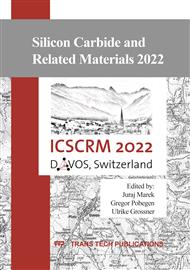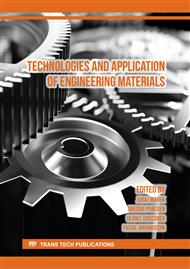[1]
V. Afanasev, M. Bassler, G. Pensl, and M. Schulz, "Intrinsic SiC/SiO2 interface states," physica status solidi (a), vol. 162, no. 1, p.321–337, 1997.
DOI: 10.1002/1521-396x(199707)162:1<321::aid-pssa321>3.0.co;2-f
Google Scholar
[2]
G. Rescher, G. Pobegen, T. Aichinger, and T. Grasser, "On the subthreshold drain current sweep hysteresis of 4H-SiC nMOSFETs," p.10–8, 2016.
DOI: 10.1109/iedm.2016.7838392
Google Scholar
[3]
R. Stahlbush and P. Macfarlane, "Light emission from interface traps and bulk defects in SiC MOSFETs," Journal of electronic materials, vol. 30, no. 3, p.188–195, 2001.
DOI: 10.1007/s11664-001-0014-2
Google Scholar
[4]
M. W. Feil, H. Reisinger, A. Kabakow, T. Aichinger, W. Gustin, and T. Grasser, "Optical emission correlated to bias temperature instability in SiC MOSFETs," International Reliability Physics Symposium, pp. 3B–1, 2022.
DOI: 10.1109/irps48227.2022.9764584
Google Scholar
[5]
M. W. Feil, H. Reisinger, A. Kabakow, T. Aichinger, C. Schleich, A. Vasilev, D. Waldhör, M. Waltl, W. Gustin, and T. Grasser, "Electrically stimulated optical spectroscopy of interface defects in wide-bandgap field-effect transistors," manuscript under review, 2022.
DOI: 10.1038/s44172-023-00053-8
Google Scholar
[6]
P. Macfarlane and R. Stahlbush, "Characterization of light emission from 4H- and 6H-SiC MOSFETs," MRS Online Proceedings Library (OPL), vol. 640, 2000.
DOI: 10.1557/proc-640-h4.9
Google Scholar
[7]
J. Cottom, G. Gruber, G. Pobegen, T. Aichinger, and A. Shluger, "Recombination defects at the 4H-SiC/SiO2 interface investigated with electrically detected magnetic resonance and ab initio calculations," Journal of Applied Physics, vol. 124, no. 4, p.045302, 2018.
DOI: 10.1063/1.5024608
Google Scholar
[8]
F. Devynck, F. Giustino, P. Broqvist, and A. Pasquarello, "Structural and electronic properties of an abrupt 4H-SiC (0001)/ SiO2 interface model: Classical molecular dynamics simulations and density functional calculations," Physical Review B, vol. 76, no. 7, p.075351, 2007.
DOI: 10.1063/1.2729890
Google Scholar
[9]
M. Bockstedte, A. Mattausch, and O. Pankratov, "Ab initio study of the migration of intrinsic defects in 3C-SiC," Physical Review B, vol. 68, no. 20, p.205201, 2003.
DOI: 10.1103/physrevb.68.205201
Google Scholar
[10]
M. Bockstedte, F. Schütz, T. Garratt, V. Ivády, and A. Gali, "Ab initio description of highly correlated states in defects for realizing quantum bits," npj Quantum Materials, vol. 3, no. 1, p.1–6, 2018.
DOI: 10.1038/s41535-018-0103-6
Google Scholar
[11]
J. Bourgoin and M. Lannoo, "Optical properties," in Point Defects in Semiconductors II, p.88– 121, Springer, 1983.
DOI: 10.1007/978-3-642-81832-5_4
Google Scholar
[12]
M. Ahoujja, H. Crocket, M. Scott, Y. Yeo, and R. Hengehold, "Photoluminescence characterization of defects introduced in 4H-SiC during high energy proton irradiation and their annealing behavior," MRS Online Proceedings Library (OPL), vol. 815, 2004.
DOI: 10.1557/proc-815-j5.21
Google Scholar
[13]
T. Egilsson, J. Bergman, I. Ivanov, A. Henry, and E. Janzén, "Properties of the D1 bound exciton in 4H- SiC," Physical Review B, vol. 59, no. 3, p.1956, 1999.
DOI: 10.1016/s0921-4526(99)00602-x
Google Scholar
[14]
A. Fissel, W. Richter, J. Furthmüller, and F. Bechstedt, "On the nature of the D1-defect center in SiC: A photoluminescence study of layers grown by solid-source molecular-beam epitaxy," Applied Physics Letters, vol. 78, no. 17, p.2512–2514, 2001.
DOI: 10.1063/1.1367883
Google Scholar
[15]
C. Haberstroh, R. Helbig, and R. Stein, "Some new features of the photoluminescence of SiC (6H), SiC (4H), and SiC (15R)," Journal of applied physics, vol. 76, no. 1, p.509–513, 1994.
DOI: 10.1063/1.357103
Google Scholar
[16]
M. Ikeda, H. Matsunami, and T. Tanaka, "Site effect on the impurity levels in 4H, 6H, and 15R SiC," Physical Review B, vol. 22, no. 6, p.2842, 1980.
Google Scholar
[17]
M. Anikin, A. Lebedev, N. Poletaev, A. Strel'Chuk, A. Syrkin, and V. Chelnokov, "Deep centers and blue-green electroluminescence in 4H-SiC," Semiconductors, vol. 28, no. 3, p.288–291, 1994.
Google Scholar
[18]
A. Galeckas, J. Linnros, and M. Lindstedt, "Characterization of carrier lifetime and diffusivity in 4H-SiC using time-resolved imaging spectroscopy of electroluminescence," Materials Science and Engineering: B, vol. 102, no. 1-3, p.304–307, 2003.
DOI: 10.1016/s0921-5107(02)00728-6
Google Scholar
[19]
N. Kuznetsov and A. Zubrilov, "Deep centers and electroluminescence in 4H-SiC diodes with a p-type base region," Materials Science and Engineering: B, vol. 29, no. 1-3, p.181–184, 1995.
DOI: 10.1016/0921-5107(94)04035-3
Google Scholar
[20]
C. Li, H. Luo, C. Li, W. Li, H. Yang, and X. He, "Online junction temperature extraction of SiC power MOSFETs with temperature sensitive optic parameter (TSOP) approach," IEEE Transactions on Power Electronics, vol. 34, no. 10, p.10143–10152, 2019.
DOI: 10.1109/tpel.2018.2890303
Google Scholar
[21]
T. Stiasny and R. Helbig, "Thermoluminescence and related electronic processes of 4H/6H-SiC," physica status solidi (a), vol. 162, no. 1, p.239–249, 1997.
DOI: 10.1002/1521-396x(199707)162:1<239::aid-pssa239>3.0.co;2-k
Google Scholar
[22]
J. Winkler, J. Homoth, and I. Kallfass, "Electroluminescence-based junction temperature measurement approach for SiC power MOSFETs," IEEE Transactions on Power Electronics, vol. 35, no. 3, p.2990–2998, 2019.
DOI: 10.1109/tpel.2019.2929426
Google Scholar
[23]
S. Ostapenko, Y. M. Suleimanov, I. Tarasov, S. Lulu, and S. Saddow, "Thermally stimulated luminescence in full-size 4H-SiC wafers," Journal of Physics: Condensed Matter, vol. 14, no. 48, p.13381, 2002.
DOI: 10.1088/0953-8984/14/48/392
Google Scholar
[24]
T. Kimoto, "Material science and device physics in SiC technology for high-voltage power devices," Japanese Journal of Applied Physics, vol. 54, no. 4, p.040103, 2015.
DOI: 10.7567/jjap.54.040103
Google Scholar
[25]
N. T. Son and I. G. Ivanov, "Charge state control of the silicon vacancy and divacancy in silicon carbide," Journal of Applied Physics, vol. 129, no. 21, p.215702, 2021.
DOI: 10.1063/5.0052131
Google Scholar
[26]
R. Hall, "Recombination processes in semiconductors," Proceedings of the IEE-Part B: Electronic and Communication Engineering, vol. 106, no. 17S, p.923–931, 1959.
DOI: 10.1049/pi-b-2.1959.0171
Google Scholar
[27]
S. Bishop, C. Reynolds Jr, J. Molstad, F. Stevie, D. Barnhardt, and R. Davis, "On the origin of aluminum-related cathodoluminescence emissions from sublimation grown 4H-SiC (1120)," Applied surface science, vol. 255, no. 13-14, p.6535–6539, 2009.
DOI: 10.1016/j.apsusc.2009.02.036
Google Scholar
[28]
L. Storasta, F. Carlsson, S. Sridhara, J. Bergman, A. Henry, T. Egilsson, A. Hallén, and E. Janzén, "Pseudodonor nature of the D1 defect in 4H-SiC," Applied Physics Letters, vol. 78, no. 1, p.46–48, 2001.
DOI: 10.1063/1.1334907
Google Scholar
[29]
N. Korsunska, I. Tarasov, V. Kushnirenko, and S. Ostapenko, "High-temperature photoluminescence spectroscopy in p-type SiC," Semiconductor science and technology, vol. 19, no. 7, p.833, 2004.
DOI: 10.1088/0268-1242/19/7/009
Google Scholar
[30]
Y. P. Varshni, "Temperature dependence of the energy gap in semiconductors," physica, vol. 34, no. 1, p.149–154, 1967.
DOI: 10.1016/0031-8914(67)90062-6
Google Scholar
[31]
H. J. von Bardeleben, J. Cantin, Y. Shishkin, R. P. Devaty, and W. J. Choyke, "Microscopic structure and electrical activity of 4H-SiC/SiO2 interface defects: An EPR study of oxidized porous SiC," vol. 457, p.1457–1462, 2004.
DOI: 10.4028/www.scientific.net/msf.457-460.1457
Google Scholar
[32]
A. Lebedev, "Deep level centers in silicon carbide: A review," Semiconductors, vol. 33, no. 2, p.107–130, 1999.
DOI: 10.1134/1.1187657
Google Scholar



